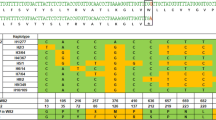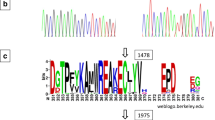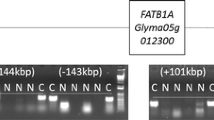Abstract
The alteration of fatty acid profiles in soybean to improve soybean oil quality has been a long-time goal of soybean researchers. Soybean oil with elevated oleic acid is desirable because this monounsaturated fatty acid improves the nutrition and oxidative stability of soybean oil compared to other oils. In the lipid biosynthetic pathway, the enzyme fatty acid desaturase 2 (FAD2) is responsible for the conversion of oleic acid precursors to linoleic acid precursors in developing soybean seeds. Two genes encoding FAD2-1A and FAD2-1B were identified to be expressed specifically in seeds during embryogenesis and have been considered to hold an important role in controlling the seed oleic acid content. A total of 22 soybean plant introduction (PI) lines identified to have an elevated oleic acid content were characterized for sequence mutations in the FAD 2-1A and FAD2-1B genes. PI 603452 was found to contain a deletion of a nucleotide in the second exon of FAD2-1A. These important SNPs were used in developing molecular marker genotyping assays. The assays appear to be a reliable and accurate tool to identify the FAD 2-1A and FAD2-1B genotype of wild-type and mutant plants. PI 603452 was subsequently crossed with PI 283327, a soybean line that has a mutation in FAD2-1B. Interestingly, soybean lines carrying both homozygous insertion/deletion mutation (indel) FAD2-1A alleles and mutant FAD2-1B alleles have an average of 82–86% oleic acid content, compared to 20% in conventional soybean, and low levels of linoleic and linolenic acids. The newly identified indel mutation in the FAD2-1A gene offers a simple method for the development of high oleic acid commercial soybean varieties.

Similar content being viewed by others
References
Anai T, Yamada T, Hideshima R, Kinoshita T, Rahman S, Takagi Y (2008) Two high-oleic-acid soybean mutants, M23 and KK21, have disrupted microsomal omega-6 fatty acid desaturase, encoded by GmFAD2–1a. Breed Sci 58:447–452
Beuselinck P, Sleper D, Bilyeu K (2006) An assessment of phenotype selection for linolenic acid using genetic markers. Crop Sci 46:747–750
Blasbalg TL, Hibbeln JR, Ramsden CE, Majchrzak SF, Rawlings RR (2011) Changes in consumption of omega-3 and omega-6 fatty acids in the United States during the 20th century. Am J Clin Nutr 93:950–962
Bolon Y-T, Haun WJ, Xu WW, Grant D, Stacey MG, Nelson RT, Gerhardt DJ, Jeddeloh JA, Stacey G, Muehlbauer GJ, Orf JH, Naeve SL, Stupar RM, Vance CP (2011) Phenotypic and genomic analyses of a fast neutron mutant population resource in soybean. Plant Physiol 156:240–253
Brace RC, Fehr WR, Schnebly SR (2011) Agronomic and seed traits of soybean lines with high oleate concentration. Crop Sci 51:534–541
Buhr T, Sato S, Ebrahim F, Xing A, Zhou Y, Mathiesen M, Schweiger B, Kinney A, Staswick P, Clemente T (2002) Ribozyme termination of RNA transcripts down-regulate seed fatty acid genes in transgenic soybean. Plant J 30:155–163
Clark KJ, Makrides M, Neumann MA, Gibson RA (1992) Determination of the optimal ratio of linoleic acid to [alpha]-linolenic acid in infant formulas. J Pediatr 120:S151–S158
Crooks G, Hon G, Chandonia J-M, Brenner S (2004) WebLogo: a sequence logo generator. Genome Res 14:1188–1190
Dhakai KH, Jeong Y-S, Baek IY, Kang NS, Yeo YK, Hwang YH (2006) Composition of oil and fatty acid in sprout and wild soybeans for specific food and industrial applications. Korean J Breed 38:236–241
Dierking E, Bilyeu K (2009) New sources of soybean seed meal and oil composition traits identified through TILLING. BMC Plant Biol 9:89
Ensminger ME, Ensminger AH (1993) Foods & Nutrition Encyclopedia, 2nd edn. CRC Press, Boca Raton
Fehr WR (2007) Breeding for modified fatty acid composition in soybean. Crop Sci 47:S-72–S-87
Friesen RW, Innis SM (2010) Linoleic acid is associated with lower long-chain n-6 and n-3 fatty acids in red blood cell lipids of Canadian pregnant women. Am J Clin Nutr 91:23–31
Graef G, LaVallee B, Tenopir P, Tat M, Schweiger B, Kinney A, Gerpen J, Clemente T (2009) A high-oleic-acid and low-palmitic-acid soybean: agronomic performance and evaluation as a feedstock for biodiesel. Plant Biotechnol J 7:411–421
Hartwig RA, Hurburgh CR (1990) Near-infrared reflectance measurement of moisture, protein and oil content of ground crambe seed. J Am Oil Chem Soc 67:435–437
Heppard E, Kinney A, Stecca K, Miao G (1996) Developmental and growth temperature regulation of two different microsomal [omega]-6 desaturase genes in soybeans. Plant Physiol 110:311–319
Hoshino T, Takagi Y, Anai T (2010) Novel GmFAD2–1b mutant alleles created by reverse genetics induce marked elevation of oleic acid content in soybean seeds in combination with GmFAD2-1a mutant alleles. Breed Sci 60:419–425
Hu FB, Stampfer MJ, Manson JE, Rimm E, Colditz GA, Rosner BA, Hennekens CH, Willett WC (1997) Dietary fat intake and the risk of coronary heart disease in women. N Engl J Med 337:1491–1499
Kim M, Go Y, Lee S, Kim Y, Shin J, Min M, Hwang I, Suh M (2010) Seed-expressed casein kinase I acts as a positive regulator of the SeFAD2 promoter via phosphorylation of the SebHLH transcription factor. Plant Mol Biol 73:425–437
Kim M, Kim J-K, Shin J, Suh M (2007) The SebHLH transcription factor mediates trans-activation of the SeFAD2 gene promoter through binding to E- and G-box elements. Plant Mol Biol 64:453–466
Kinney AJ (1996) Development of genetically engineered soybean oils for food applications. J Food Lipids 3:273–292
Lee JD, Woolard M, Sleper DA, Smith JR, Pantalone VR, Nyinyi CN, Cardinal A, Shannon JG (2009) Environmental effects on oleic acid in soybean seed oil of Plant Introductions with elevated oleic concentration. Crop Sci 49:1762–1768
Mozaffarian D, Katan MB, Ascherio A, Stampfer MJ, Willett WC (2006) Trans fatty acids and cardiovascular disease. N Engl J Med 354:1601–1613
Okuley J, Lightner J, Feldmann K, Yadav N, Lark E, Browse J (1994) Arabidopsis FAD2 gene encodes the enzyme that is essential for polyunsaturated lipid synthesis. Plant Cell 6:147–158
Oliva M, Shannon J, Sleper D, Ellersieck M, Cardinal A, Paris R, Lee J (2006) Stability of fatty acid profile in soybean genotypes with modified seed oil composition. Crop Sci 46:2069–2075
Pham A-T, Lee J-D, Shannon JG, Bilyeu K (2010) Mutant alleles of FAD2-1A and FAD2-1B combine to produce soybeans with the high oleic acid seed oil trait. BMC Plant Biol 10:195
Ramensky V, Bork P, Sunyaev S (2002) Human non-synonymous SNPs: server and survey. Nucleic Acids Res 30:3894–3900
Reinprecht Y, Luk-Labey SY, Larsen J, Poysa VW, Yu K, Rajcan I, Ablett GR, Pauls KP (2009) Molecular basis of the low linolenic acid trait in soybean EMS mutant line RG10. Plant Breed 128:253–258
Schlueter J, Lin J, Schlueter S, Vasylenko-Sanders I, Deshpande S, Yi J, O’Bleness M, Roe B, Nelson R, Scheffler B, Jackson S, Shoemaker R (2007a) Gene duplication and paleopolyploidy in soybean and the implications for whole genome sequencing. BMC Genomics 8:330
Schlueter J, Vasylenko-Sanders I, Deshpande S, Yi J, Siegfried M, Roe B, Schlueter S, Scheffler B, Shoemaker R (2007b) The FAD2 gene family of soybean:Insights into the structural and functional divergence of a paleopolyploid genome. Crop Sci 47:S14–S26
Soystats (2010) http://www.soystats.com/
Tang G, Novitzky W, Griffin H, Huber S, Dewey R (2005) Oleate desaturase enzymes of soybean: evidence of regulation through differential stability and phosphorylation. Plant J 44:433–446
Taylor DC, Katavic V, Zou J, MacKenzie SL, Keller WA, An J, Friesen W, Barton DL, Pedersen KK, Michael Giblin E, Ge Y, Dauk M, Sonntag C, Luciw T, Males D (2002) Field testing of transgenic rapeseed cv. Hero transformed with a yeast sn-2 acyltransferase results in increased oil content, erucic acid content and seed yield. Mol Breed 8:317–322
Warner K, Gupta M (2005) Potato chip quality and frying oil stability of high oleic acid soybean oil. Food Sci 70:395–400
Yadav NS, Wierzbicki A, Aegerter M, Caster CS, Perez-Grau L, Kinney AJ, Hitz WD, Booth JR Jr, Schweiger B, Stecca KL, Allen SM, Blackwell M, Reiter RS, Carlson TJ, Russell SH, Feldmann KA, Pierce J, Browse J (1993) Cloning of higher plant [omega]-3 fatty acid desaturases. Plant Physiol 103:467–476
Yusem G, Pintauro P (1992) The electrocatalytic hydrogenation of soybean oil. J Am Oil Chem Soc 69:399–404
Zheng P, Allen WB, Roesler K, Williams ME, Zhang S, Li J, Glassman K, Ranch J, Nubel D, Solawetz W, Bhattramakki D, Llaca V, Deschamps S, Zhong G-Y, Tarczynski MC, Shen B (2008) A phenylalanine in DGAT is a key determinant of oil content and composition in maize. Nat Genet 40:367–372
Acknowledgments
The authors wish to acknowledge the excellent technical assistance provided by Paul Little, Christine Cole and Stewart Selves.
Conflict of interest
None.
Author information
Authors and Affiliations
Corresponding author
Additional information
Communicated by B. Diers.
Rights and permissions
About this article
Cite this article
Pham, AT., Lee, JD., Shannon, J.G. et al. A novel FAD2-1 A allele in a soybean plant introduction offers an alternate means to produce soybean seed oil with 85% oleic acid content. Theor Appl Genet 123, 793–802 (2011). https://doi.org/10.1007/s00122-011-1627-3
Received:
Accepted:
Published:
Issue Date:
DOI: https://doi.org/10.1007/s00122-011-1627-3




